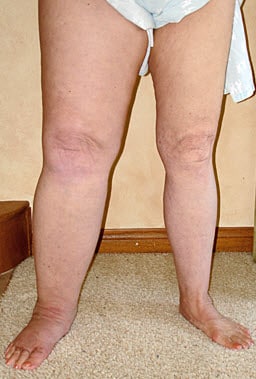Lymphedema Symptoms, Causes, and Treatment
What is Lymphedema?
 Lymphedema is an accumulation of fluid due to a back-up or congestion in the lymphatic system.
Lymphedema is an accumulation of fluid due to a back-up or congestion in the lymphatic system.
There are two types, primary and secondary. Primary is genetically driven. It is a condition one is born with (congenital), and develops just after puberty or pregnancy (praecox), or after the age of 35 (tarda). Contributing factors to the development of lymphedema praecox and tarda include obesity, and specific types of arthritis. Secondary lymphedema is caused by other health conditions such as cancer, surgery, or infection.
Patient Testimonial
"Jilanne has done an amazing job fixing my mother's legs. My mom suffered from really bad varicose veins, swelling, and bloody discharge for years and no one would treat her because of how bad it was. Jilanne was very supportive and positive about what she could do for us. One week after the laser procedures, my mother's leg pain is 90% better and she's walking without a walker or wheelchair for the first time in years! Thank you to all of you at Advanced Vein Institute."
Emily in Scottsdale, AZ
Advanced Vein Institute Patient
Venous Hypertension and Associated Lymphedema
Lymphedema chronically progresses - the swelling produces more swelling. The venous system and the lymphatics are very closely related. The swelling comes from fluid collecting within the soft tissue, from a venous obstruction or lymphatic congestion. Normally, the fluid must make its way back to the central system and returns to the heart, either by venous or by lymphatic routes. When venous hypertension, essentially high blood pressure inside the vein caused from broken one-way valves inside the veins of the legs and pelvis, is present, the fluid overloads the lymphatic system and it can't offset the veins that are not working. This fluid overload results in a combination of venous hypertension swelling with associated lymphedema.
The Symptoms of Lymphedema vary greatly but can include:
- heaviness in one or both lower extremities
- significant edema
- skin pigmentation changes
- discoloration
- weeping of clear fluid
- open wounds
- recurrent skin
- soft tissue infections

Patient Testimonial
I have been to other doctors for my veins, but Dr. Rose surpasses them in the way she let's me know what the treatment will be for my veins, how many treatments, and what my options are. She is very kind, friendly and thorough. I would recommend her to everyone who has varicose veins.
Mona W.
Advanced Vein Institute Patient
Lower Extremity Lymphedema Treatment
 Unfortunately, there is no cure for lymphedema but there are treatments that currently exist which include lymphatic massage (also referred to as lymphedema massage) and lymphedema therapy. These treatments as guided by a qualified Vein Specialist are aimed at improving quality of life by managing symptoms.
Unfortunately, there is no cure for lymphedema but there are treatments that currently exist which include lymphatic massage (also referred to as lymphedema massage) and lymphedema therapy. These treatments as guided by a qualified Vein Specialist are aimed at improving quality of life by managing symptoms.
Venous insufficiency will often contribute to the overall symptoms of Lymphedema and the physical appearance of one’s legs. For this reason, at Advanced Vein Institute of Arizona, we begin each evaluation with a duplex ultrasound to assess both the vascular and lymphatic systems. This will provide the patient with a complete picture of their lower extremity condition. Based upon the ultrasound findings, treatment options include a combination of conservative therapies, and if necessary, venous intervention which will often radically improve symptoms.
Benefits of Lymphedema Treatment
The primary goal of any treatment is to improve a patient’s quality of life. Treatment will generally provide:
- reduced fluid volume and swelling
- decreased pain
- reduced risk of infection
- improved skin appearance
- increased range of motion and mobility
- improved limb appearance and skin integrity
Again, there is no cure, however, a dramatic improvement in the lower extremities and quality of life can be made with conservative and minimally invasive therapies.
Next Steps for Lymphedema Evaluation
A Duplex Ultrasound by our expert vein specialist is the most reliable, fastest way to fully understand your specific health concerns with regards to lower extremity lymphedema and venous insufficiency.
Are you ready to get started?
Not quite sure yet?
Why not read what other patients have said, we love to share feedback!


![AdobeStock_124052634_Preview-104244-edited[1] AdobeStock_124052634_Preview-104244-edited[1]](https://advancedveinaz.com/wp-content/uploads/2018/10/AdobeStock_124052634_Preview-104244-edited1.jpeg)